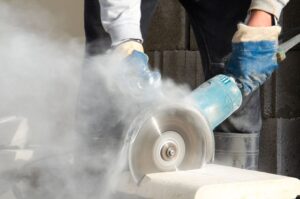Health and Safety Executive cracks down on dust
Health and safety inspectors across Great Britain will be targeting construction firms to check that their health standards are up to scratch during a month-long inspection initiative, starting on Monday 5 October 2020.
This is the fourth health-focused initiative of its kind. As in previous years, inspections will focus on respiratory risks and occupational lung disease; looking at the measures businesses have in place to protect their workers’ lungs from the likes of asbestos, silica and wood dust. This is part of HSE’s longer term health and work strategy to improve health within the construction industry.
While the primary focus will be on health during this programme of inspections, if a HSE inspector identifies any other areas of concern, they will take the necessary enforcement action to deal with them. This will include making sure that businesses are doing all they can to protect their workers from the risk of coronavirus and make workplaces COVID-secure.

Inspectors will also be looking for evidence of employers and workers knowing the risks, planning their work and using the right controls. If necessary, they will use enforcement to make sure people are protected.
The construction initiative will be supported by HSE’s ‘Dustbuster’ campaign, aimed to influence employer behaviour by encouraging builders to download free guidance and advice, increasing knowledge and capability to protect workers’ health.
More than 3,500 builders die each year from cancers related to their work, with thousands more cases of ill-health and working days lost.
HSE’s chief inspector of construction, Sarah Jardine, said: “Around 100 times as many workers die from diseases caused or made worse by their work than are actually killed in construction accidents.
“Our inspection initiatives ensure that inspectors are able to speak to dutyholders and visit sites to look at the kind of action businesses in the construction industry are taking right now to protect their workers’ health, particularly when it comes to exposure to dust and damage to lungs.
“There are a few simple things that everyone can do to make sure they are protecting their health and their future. Be aware of the risks associated with activities you do every day, recognise the dangers of hazardous dust and consider how it can affect your health. We want businesses and their workers to think of the job from start to finish and avoid creating dust by working in different ways to keep dust down and wear the right mask and clothing.”
For more information on the programme of inspections follow the campaign on Twitter at @H_S_E, or on Facebook @hsegovuk and @SaferSites. You can also join the conversation at #Dustbuster. To sign up for HSE’s construction e-bulletin go to: hse.gov.uk/construction/infonet.htm
Notes to Editors:
- The Health and Safety Executive (HSE) is Britain’s national regulator for workplace health and safety. We prevent work-related death, injury and ill health through regulatory actions that range from influencing behaviours across whole industry sectors through to targeted interventions on individual businesses. These activities are supported by globally recognised scientific expertise. hse.gov.uk
- HSE news releases are available at http://press.hse.gov.uk
The post Health and Safety Executive cracks down on dust appeared first on HSE Media Centre.
